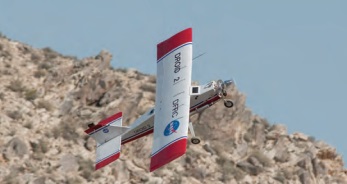Chapter: Collision Avoidance Technologies, new invention technology, Research project papers,
Improved Ground Collision Avoidance System (iGCAS) for UAVs

Improved Ground
Collision Avoidance System (iGCAS) for UAVs
This research project
is testing and validating automatic iGCAS software technology for use on UAVs
in a variety of terrain conditions. The technology outperformed engineering
expectations in a series
of demonstration
flights using a small, remotely operated integrated drone research plane. The
team adapted the iGCAS software into an application for the Android smart phone
linked to a small Piccolo Autopilot. The small drone is an affordable,
low-risk, and effective way to test the miniaturized iGCAS system before an
operational system can be installed on a multi-million-dollar unmanned aircraft
like Armstrong's Ikhana, which is one of the project's eventual goals.
Work to date: The project team successfully validated the
iGCAS software in a series of UAV flight tests on the Dryden
Aeronautical Test Range. The iGCAS repeatedly executed pull-ups and sharp turns
to avoid imminent terrain impact and many times extricated the UAV from a box
canyon.
Looking ahead: When fully developed
and matured, the miniaturized iGCAS technology could have wide
applications for potential use in general aviation aircraft, including crewed
and remotely/autonomously operated unmanned aircraft systems. In 2014 the
research team intends to incorporate obstacle avoidance and a specialized pilot
interface for general aviation use.
Benefits
Increases
safety: Provides the framework for analytical systems that can
learn, predict, and adapt to both routine and emergency situations
Portable and affordable: Enables implementation
on existing aircraft systems and on tablets and smart phones
Applications
UAVs (navigation and research)
Military and civil aeronautics (collision avoidance,
aerial firefighting, crop dusting)
Collision Avoidance Technologies
Researchers at Armstrong are dramatically improving upon
existing ground collision avoidance technology for aircraft. Controlled flight
into terrain remains a leading cause of fatalities in aviation, resulting in
roughly 100 deaths each year in the United States alone. Although warning
systems have virtually eliminated this problem for large commercial air
carriers, the problem still remains for fighter aircraft, helicopters, and
general aviation.
Armstrong innovators have been working with the U.S. Air Force
for more than 25 years to develop automatic col-lision avoidance technologies
for fighter aircraft that would reduce the risk of ground collisions, the
leading cause of fatalities in both military and general aviation. The result
of the collaboration is lifesaving technology that incorporates onboard digital
terrain mapping data with data-adaptive algorithms that predict impending
ground collisions.
Related Topics